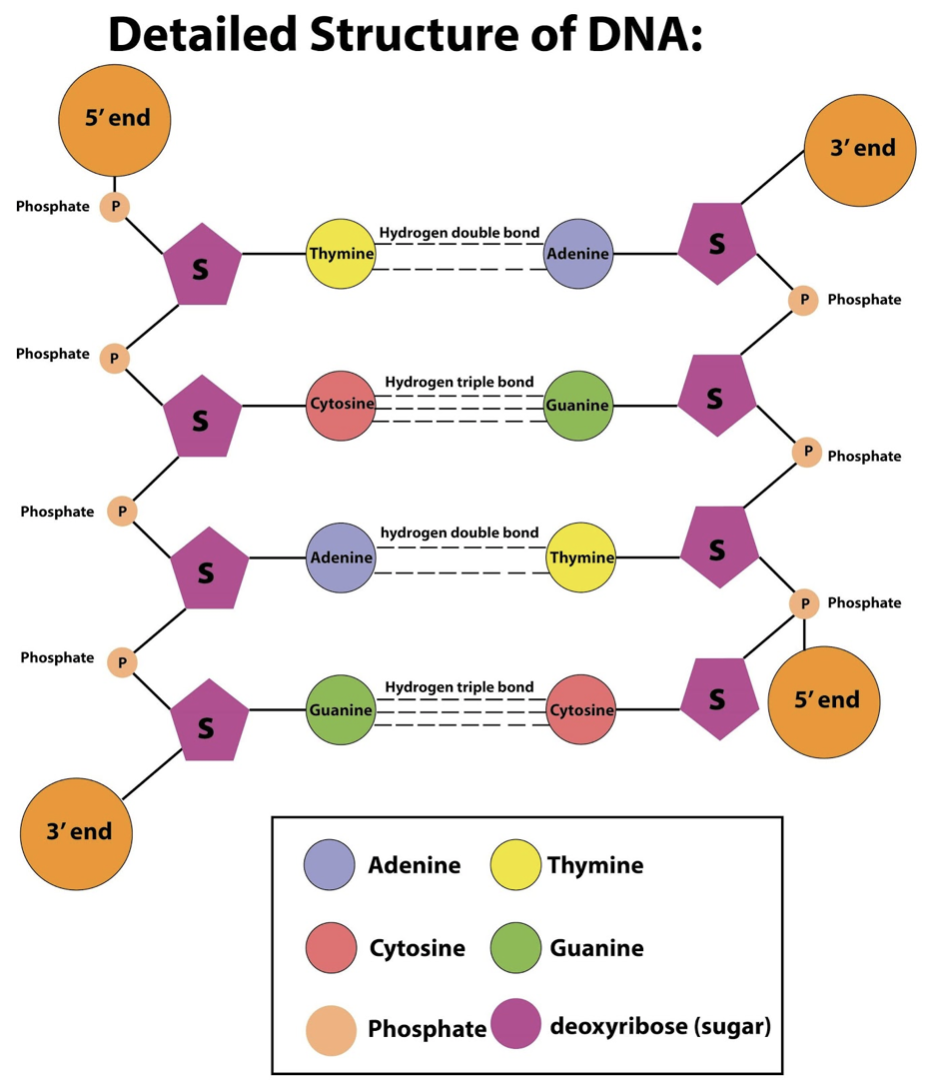Answer
405.3k+ views
Hint: A DNA molecule is said to be melted when the two strands of it are separated due to the heat and high temperature supplied. The two DNA strands are connected to each other by hydrogen bonds which are made between the nitrogenous base pairs of each strand.
Complete Answer:
DNA is made up of two types of nitrogenous bases known as purines and pyrimidines. And each purine binds with a pyrimidine with the help of hydrogen bonds. The purines are adenine (A) and guanine (G) and the pyrimidines are cytosine (C), thymine (T), and uracil (U) are present in the structure of nucleic acids.

Adenine bonds with thymine through two hydrogen bonds whereas cytosine bonds with guanine with three hydrogen bonds. Thus in order to break the two strands of DNA apart, it will be easier to break the adenine thymine bond as there are only 2 hydrogen bonds present. The DNA strand with more number of adenine thymine bonds and less number of guanine-cytosine bonds will melt at the lowest temperature i.e. $\begin{matrix} 5’-A-A-T-A-A-A-G-C-T-3’ \\
3’-T-T-A-T-T-T-C-G-A-5’ \end{matrix}$
Additional information: Let us look at the structure of DNA.
- The DNA is made up of a repeating unit known as nucleotide which is joined together with the help of phosphodiester bonds.
- Nucleotide is itself made up of three parts known as the nitrogenous base, sugar, and a phosphate group.
- The nitrogenous base bonds with the sugar to form a structure known as a nucleoside.
- This nucleoside attaches to the phosphate group to give nucleotides.
- The nitrogenous bases present in this nucleotide also bond to the nitrogenous bases from the other strand to give rise to a double-helical structure.
So, the correct answer is $\begin{matrix}5’-A-A-T-A-A-A-G-C-T-3’ \\
3’-T-T-A-T-T-T-C-G-A-5’ \end{matrix}$
Note:
- In RNA, we see uracil bonded to adenine in place of thymine.
- DNA and RNA differ in the sugar as RNA has ribose sugar whereas DNA has deoxyribose sugar.
- Phosphodiester bonds are formed by the reaction between a phosphate group and an alcohol group.
Complete Answer:
DNA is made up of two types of nitrogenous bases known as purines and pyrimidines. And each purine binds with a pyrimidine with the help of hydrogen bonds. The purines are adenine (A) and guanine (G) and the pyrimidines are cytosine (C), thymine (T), and uracil (U) are present in the structure of nucleic acids.

Adenine bonds with thymine through two hydrogen bonds whereas cytosine bonds with guanine with three hydrogen bonds. Thus in order to break the two strands of DNA apart, it will be easier to break the adenine thymine bond as there are only 2 hydrogen bonds present. The DNA strand with more number of adenine thymine bonds and less number of guanine-cytosine bonds will melt at the lowest temperature i.e. $\begin{matrix} 5’-A-A-T-A-A-A-G-C-T-3’ \\
3’-T-T-A-T-T-T-C-G-A-5’ \end{matrix}$
Additional information: Let us look at the structure of DNA.
- The DNA is made up of a repeating unit known as nucleotide which is joined together with the help of phosphodiester bonds.
- Nucleotide is itself made up of three parts known as the nitrogenous base, sugar, and a phosphate group.
- The nitrogenous base bonds with the sugar to form a structure known as a nucleoside.
- This nucleoside attaches to the phosphate group to give nucleotides.
- The nitrogenous bases present in this nucleotide also bond to the nitrogenous bases from the other strand to give rise to a double-helical structure.
So, the correct answer is $\begin{matrix}5’-A-A-T-A-A-A-G-C-T-3’ \\
3’-T-T-A-T-T-T-C-G-A-5’ \end{matrix}$
Note:
- In RNA, we see uracil bonded to adenine in place of thymine.
- DNA and RNA differ in the sugar as RNA has ribose sugar whereas DNA has deoxyribose sugar.
- Phosphodiester bonds are formed by the reaction between a phosphate group and an alcohol group.
Recently Updated Pages
How many sigma and pi bonds are present in HCequiv class 11 chemistry CBSE

Why Are Noble Gases NonReactive class 11 chemistry CBSE

Let X and Y be the sets of all positive divisors of class 11 maths CBSE

Let x and y be 2 real numbers which satisfy the equations class 11 maths CBSE

Let x 4log 2sqrt 9k 1 + 7 and y dfrac132log 2sqrt5 class 11 maths CBSE

Let x22ax+b20 and x22bx+a20 be two equations Then the class 11 maths CBSE

Trending doubts
Fill the blanks with the suitable prepositions 1 The class 9 english CBSE

At which age domestication of animals started A Neolithic class 11 social science CBSE

Which are the Top 10 Largest Countries of the World?

Give 10 examples for herbs , shrubs , climbers , creepers

Difference between Prokaryotic cell and Eukaryotic class 11 biology CBSE

Difference Between Plant Cell and Animal Cell

Write a letter to the principal requesting him to grant class 10 english CBSE

Change the following sentences into negative and interrogative class 10 english CBSE

Fill in the blanks A 1 lakh ten thousand B 1 million class 9 maths CBSE



